The end of an era for China
- Published

Probably the least surprising thing about China's GDP growth rate for the first three months of the year is that it slowed to 7%. After all, that's the target for the year.
What's more surprising are the drivers: consumption more than investment, services outpacing manufacturing, and domestic demand rather than exports. Taking today's figures and the data for March together with the full year picture for 2014 shows that China's growth drivers are changing.
Consumption contributed 3.8 percentage points to 2014's 7.4% growth rate, which is more than investment which accounted for 3.6 percentage points. Net exports - so exports minus imports - contributed nothing.
Consumption has risen to account for more than 50% of GDP, which is a sizeable increase from 2009's 35%, and finally places China in the realm of market economies where consumption is between half to two-thirds of GDP.
It mirrors the rise of the services part of the economy, which includes non-tradeables like haircuts, becoming larger than manufacturing that included many exported goods.
Real estate risk
Indeed, industrial production in March expanded by 5.6%, the slowest on record, which was significantly outpaced by retail sales - a measure of consumption - which grew at over 10%.
This is what China has been trying to achieve - a re-balancing of its economy away from excessive reliance on exports and investment and more on its own middle class consumers and expanding services.
It's part of their aim of overcoming the middle income country trap to become prosperous by improving the quality of the growth drivers in the economy.
Growing more through consumption and services is similar to the growth drivers of developed economies such as the U.S. and Europe. So, China's re-balancing also marks the beginning of the end of a period of rapid growth that is based on industrialisation.
Manufacturing and "catching up" launched China from a poor to a middle income country in the past 35 years. The next stage is growing as a middle income economy, which will naturally be slower than the initial phase.
Statistical uncertainty
After all, 5% growth for an emerging market looks slow while 3% growth for a developed one would be considered fast.
Still, any slowdown poses risks. For China, it is notably in terms of real estate and investment which may be slowing down too quickly and poses a risk for banks. It is why the government has introduced measures to support the housing market and cut interest rates to stimulate lending.
The government is also likely to spend to support the economy if job growth slows. But, so far, a slower growth rate hasn't meant fewer jobs since a services economy is labour-intensive and last year saw 13 million plus jobs created against a 10 million target.
The unemployment rate is 5.1% - though that's likely to be mis-measured since rural area employment isn't well captured.
So, the picture in terms of re-balancing looks better than the headline growth rate of the slowest quarterly growth rate since the global financial crisis. But, the biggest uncertainties lie beyond the macroeconomic statistics, which aren't always reliable, and instead reside in the micro picture for the financial system.
Dramatic transformation
The IMF yesterday downgraded China's growth to below 7% this year and next year. If growth slows down considerably - even if planned as part of the restructuring of the economy - then will lower demand affect the ability to repay loans?
Commercial developers are leveraged and there are reported difficulties in leasing office space. House prices have fallen across the country and requirements have been loosened for mortgages.
These are questions that will undoubtedly be raised as China seeks to do what no other country has done, which is to overcome the middle income trap for a billion-plus population.
What the rest of the world also has never experienced is its second largest economy undertaking such a dramatic structural transformation that is likely to entail volatility.
The U.S. growth engine looks like it's coming back, and it's certainly not too soon as the era of rapid growth in China comes to an end.